Every rugby team starts a match with one hooker on the pitch who wears the number two jersey and a replacement on the bench.
This article explains the important role of hookers in a rugby match.
We have a separate article on hookers in sevens rugby. This article is about the fifteen-player sport. So, let’s start with the most basic question…
What Is A Hooker In Rugby?
The hooker in rugby has a specialist role in the scrum and the lineout.
Their role in the scrum is to pack down in the middle of the front row and move the ball back to the number eight.
Their role in the lineout is to throw the ball down the middle of the two lines of opposing forwards.
Hookers are usually a little shorter and lighter than the two props in the front row. However, they are usually heavier than many other forwards and need considerable strength.
The increasing importance of lineouts for attacking moves has put extra emphasis on hookers to perfect their throwing skills.
How Did Hookers Get Their Name?
When the scrumhalf rolls the ball into the scrum, the hooker must control and move the ball backward to land beneath the feet of the number eight.
The hooker uses the instep of one foot to stop the rolling ball and taps it backward. This is known as “hooking” the ball.
This is why the position is called a hooker i.e. someone who hooks.
Role Of Hookers In Scrummaging
We’ve already described how hookers push the ball back in the scrum.
But they also have an important role in scrummaging against the opposition.
This diagram shows how the hooker is positioned between the two prop forwards on either side in the front row.
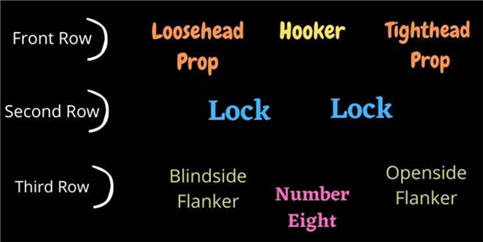
We have a separate article that explains the crucial role of props in the scrum. They provide much of the pressure on pushing against the opposition.
Do hookers push in the scrum?
Hookers have two locks pushing behind them. They must ensure that this force is transferred through to the opposition.
Hookers must work hard to ensure that the force behind them doesn’t simply push them upwards.
You’ll sometimes see the referee stop the scrum because the front row has stood up. This is often the fault of the hooker.
The referee may reset the scrum, but repeated problems will result in a free kick or penalty to the opposition.
Concerns about hooker injuries
In recent years, experienced hookers started to raise concerns about the amount of force being brought to bear on their necks in the scrum.
They were worried about long-term consequences from this repeated load over years.
I’ve explained this in detail in our article on axial loading and the brake foot. Don’t be boggled by the terminology, that article has simply diagrams to show what was going on.
World Rugby introduced changes in 2019 to how referees control the scrum. The effects are still being monitored to see if they reduce neck injuries.
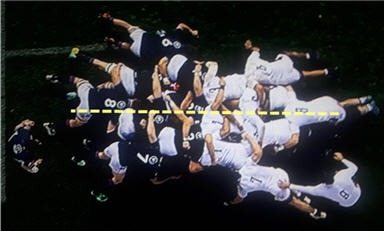
The Hooker Position Is Mandatory
There is no law that says that a winger couldn’t swap with a flanker and pack down in the back row of a scrum.
However, the hooker position is mandatory. Only the named starting hooker can pack down in the middle of the front row.
The coach must also state which player on the bench is qualified to replace the starting hooker.
The reason for these strict rules is that an inexperienced hooker could suffer serious neck or back injuries in a collapsed scrum.
What if the team runs out of hookers?
What if the starting and replacement hooker gets injured before the end of the match?
The coach is allowed to nominate another player who is capable of playing the hooker role.
Many props played at hooker at school. Some may not have shifted to prop until their early twenties. Their club may choose to nominate them as a third replacement hooker.
However, this is rare.
It’s more likely that the team can’t rustle up a third hooker. In this situation, the referee will not allow a normal scrum to take place.
Uncontested scrums
The next time that a scrum is required, the referee will order “uncontested scrums”.
This means that the two packs pack down against each other, but are not allowed to push.
Role Of Hooker In The Lineout
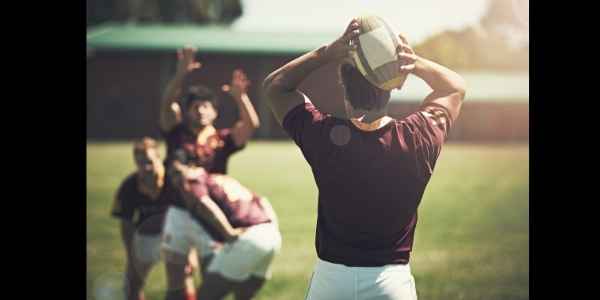
In modern rugby, the hooker throws the ball into the lineout.
This isn’t mandatory. Any player can throw in the ball. Historically, wingers and scrumhalves use to do it. We explain why that changed in our article on why hookers throw into the lineout.
Hookers train hard for this specialist skill.
Hooker throwing skills
Lineouts would be a lot easier if the hooker could chuck the ball straight at his nearest teammate.
However, one of the principles of rugby is that there must be a fair contest for the ball.
This means that hookers must throw the ball straight down the middle of the gap between the opposing forwards. Otherwise, the referee will award an infringement.
Because the ball is thrown straight, the lineout becomes a complex symphony of timing, trajectory, throwing, and jumping.
Hookers get the blame
When the hooker throws the ball five meters squint of a straight line, then the fault is pretty clear.
If you want to know more, check out our article on what happens when a lineout isn’t straight.
But lineouts can also go wrong when an opposition forward successfully intercepts or “steals” the ball.
Fans usually throw up their hands and groan admonishments at their hooker.
However, the fault may be in the skill of the jumper or the timing of the lifters. Hookers will tell you that this doesn’t matter. They always get the blame!
How Tall Is The Average Hooker?
The average professional hooker is 1.82 meters or 5’11.
This average is calculated from heights of players in the England Premiership, the French Top 14, and the United Rugby Championship.
The chart below shows how hookers compare to the other rugby positions.
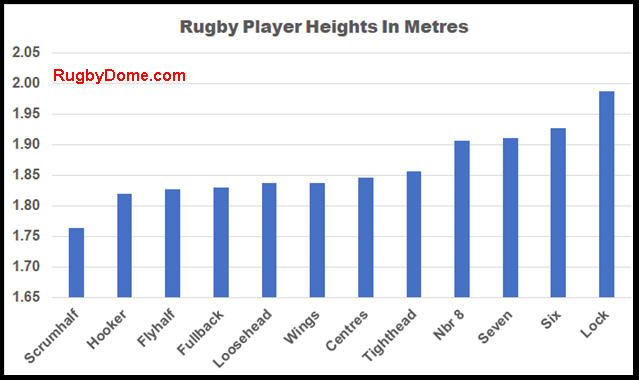
As you can see, hookers tend to be the second smallest players on the pitch. They are significantly taller than scrumhalves (the shortest) but hookers are the smallest forwards.
Why are rugby hookers short?
Hookers are shorter than other forwards because of their role in the scrum.
The most powerful scrum position is to scrummage as low as possible without collapsing.
When the front row packs down, the hooker sets the height of the scrum with each arm bound to the prop on either side.
Shorter hookers have the advantage of being able to scrummage lower than a taller player.
How Heavy Should Hookers Be?
The average weight of a professional hooker is 106 kgs or 16 st 11 lbs.
As you can see from the chart below, hookers are lighter than props and locks. They tend to be a similar weight to the backrow players.
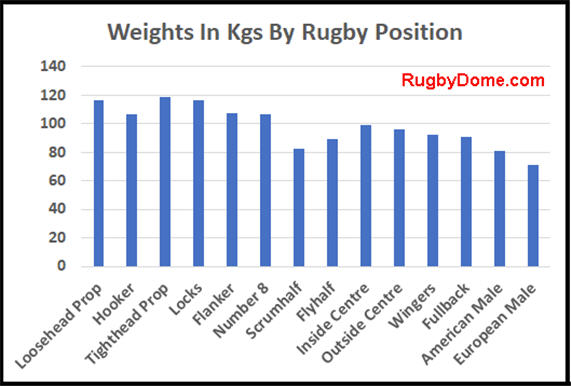
If you want the full numbers from this chart, check out our article on average weights of rugby players.
Modern Hookers Are Mobile And Dynamic
Hookers used to have two roles: hook the ball in the scrum and throw the ball into the lineout.
Other than that, they had to move around the pitch at a slow pace and protect a few rucks.
The modern game places much more demands on the role.
Because they don’t need to be quite as strong as prop forwards, coaches tend to pick more athletic players who can mix it up in open play.
Hookers are often positioned wide on the wing during attacking play.
If the ball reaches them, they have enough pace to run for significant yards and enough bulk not to be bundled into touch when tackled.
Scoring tries
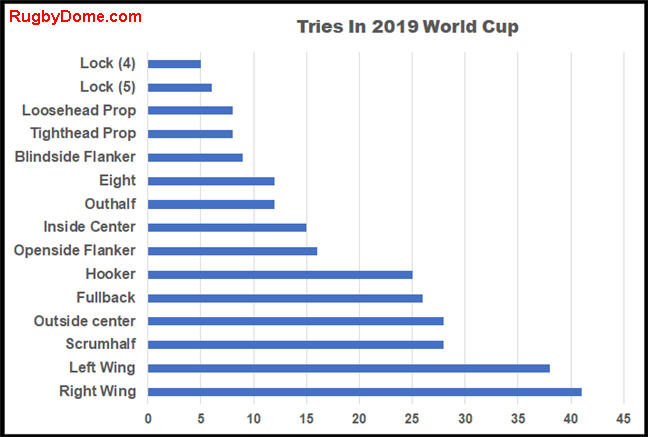
The chart above shows that in the 2019 Rugby World Cup, hookers scored the most amount of tries amongst forwards.
If you want a full rundown, check out our article on try-scoring rates across rugby positions.
Admittedly, these tries aren’t blazing runs down the touchlines.
Many are when hookers burrow over when their team has set up camp in rucks near the try line.
Many others are scored from the back of a rolling maul when the hooker flops to the floor holding the ball.
Who Are The Legends Of The Game?
It was a hard job to draw up a list of the greatest hookers in rugby, but someone had to do the job.
You may not agree with our picks, but we explain why we have each one as a modern legend.
Other Positions
Our general overview of positions in rugby union has links to in-depth articles for each playing position.